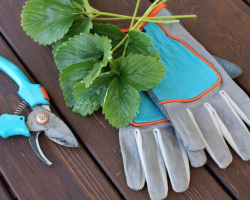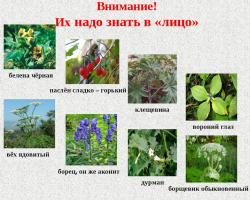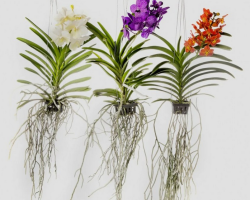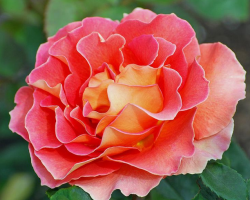In this article, we are stuck about how to properly plant pumpkin seeds, when to do it and how to properly care for culture.
Content
- Planting pumpkin seeds - which is better?
- When to plant a pumpkin: term
- How to germinate pumpkin seeds before planting: instructions, recommendations
- How to prepare the soil for planting pumpkin seeds?
- Sowing pumpkin seeds for seedlings: instructions, recommendations
- How to plant a pumpkin with seeds in open ground: Instructions
- How to plant a pumpkin correctly: schemes
- Pumpkin growing methods: methods, recommendations
- How to care for pumpkin in open ground: recommendations, tips
- What are the diseases and pests of pumpkin?
- Video: How to plant a pumpkin? A simple but very effective method for obtaining a crop!
Pumpkin is one of the popular crops that are grown in dachas and personal plots. It is used for the preparation of side dishes or salads. It is even completely baked or baby food is cooked. Some varieties are specially grown for animal feed or just as a decorative plant. The advantage of pumpkin is that it is unpretentious in care. Our article will tell you how to plant it correctly and how to care for it.
Planting pumpkin seeds - which is better?

Many novice gardeners who first decided to plant a pumpkin are wondering - which is better to choose? In this case, everyone decides. However, all varieties have certain features that are important to consider:
- Muscal pumpkin. This category includes such a podzort as vitamin, marble, tsukatnaya, arbat and pearl. The fruits are characterized by a round or cylindrical shape, the crust is quite soft, and the color is saturated. Muscate pumpkins are distinguished by a long shelf life, about two years, as well as excellent taste.
- The pumpkin is hard -brown. It differs with a round-cylindrical shape and orange. She has a pleasant sweet taste. The variety differs in that it has a very hard crust, which is difficult to cut.
- The pumpkin is large -fruited. In this category, a juno, Grandemyanka, mushroom bush, freckles, almond, country, country, are distinguished. It has high yields, soft crust and large fruits.
In open ground, it is allowed to grow completely any varieties, since the culture itself is unpretentious. Most importantly, observe the rules of landing and the features of care.
When to plant a pumpkin: term
Before planting a pumpkin, you need to understand when you should do it at all. The fact is that although culture does not require careful care, it loves warmth. Therefore, it needs to be planted when the air temperature warms up to +20 ... +25 degrees during the day and +18 at night. When the temperature drops to +14 degrees or below, the fruits cease to grow. Regardless of the landing method, you can plant pumpkin on the beds only after short -term frosts stop. Keep in mind that the soil temperature should not be lower than +11 degrees.
Depending on the region, planting terms differ. This is due to climatic conditions. So, the plant can be planted as follows:
- In the northern regions, the period falls on the end of spring - the beginning of summer
- In the middle lane of landing can be carried out already in the second decade of May
- The southern regions allow you to plant pumpkin from mid -April to mid -May
If you are planting through seedlings, then count from these terms for about 25-30 days. That is how much time is required by the plant in order to gain strength and grow.
In addition, in the middle and northern strip, it is recommended to plant only hard -crusted varieties in open ground. But muscators, even in the south, are grown through seedlings two weeks later than other species.
How to germinate pumpkin seeds before planting: instructions, recommendations

To get a good pumpkin crop in the new year, you need to prepare for the season in advance. To do this, dig the site and add organic fertilizers into the soil. In the spring, carefully inspect the seeds and remove those that have chips on the surface. It is recommended to germinate seeds for 4-7 days. During this time, they should give roots. After that, you can plant a pumpkin for seedlings.
The process of germination of seeds allows you to choose the strongest samples. There are two main methods of germination. Each gardener can choose the right one.
Method 1. A napkin or wet fabric
At home, pumpkin seeds, as a rule, are germinated in a traditional way - in a plate that covers with gauze or other dense fabric. Seeds are laid out on top and poured with water. While the sprouts do not appear, the fabric should always be wet. But the main thing is not to overdo it. If the fabric is wet, that is, flooded with water, the grains can be bent.
Another option is to use a linseed bag. Pour the seeds into it and lower it twice a bag into a container of water for one minute. After the procedure, the bag is suspended so that the liquid drains from it.
The first method still remains the most popular, but it is impossible to place a container near heat sources, otherwise the water will evaporate very quickly.
Method 2. Bank
The advantage of this method is that the sprouts appear much faster, because inside the conditions are created similar to greenhouse. The method itself is simplicity.
Planting is carried out as follows:
- First, pour pumpkin grains into the jar. It is important that they completely close the bottom
- Close the container with a lid, but make the holes in it first. Or use gauze. It is fixed with an elastic band at the throat of the jar
- Pour 2-3 liters of running water through the lid. This will allow you to rinse seeds
- After the washing is completed, pour the water into the jar half and leave it for 8-10 hours
- After that, place the jar horizontally. Place the container under it so that the water is where to drain. The most convenient option is the location above the sink
- Repeat the procedure with washing 2-3 times daily
Keep in mind that until the first sprouts have broken through the grains, the container should be in a warm place.
Already immediately before planting, when the sprouts appear, the seeds are disinfected, soak and stimulate their curse. For this, peat cups are suitable. They are good in that when transplanting from them, you do not need to get seedlings. You can bury them in the ground, where they will become an additional source of nutrition.
Another way is a snail. For him, the fabric where the seeds are wrapped. It must be moistened regularly, but at the same time avoiding moisture stagnation. Otherwise, the seedlings will rot.
Many are also interested in how many days the first shoots appear. In this case, it is difficult to unequivocally answer the question, since the swiftness of the process largely depends on the quality of the sowing material and the correctness of its preparation. On average, it takes 5-7 days to the appearance of sprouts. And the seeds are completely damaged about eight days.
How to prepare the soil for planting pumpkin seeds?
To plant a pumpkin, as we have already said, you need to prepare since the fall. Plan a place for future landing in advance, and then proceed to work.
First of all, free the plot from weeds and other crops that have grown in you during the year. You can’t do without organic fertilizer. To prepare it, mix 60 grams of superphosphate, 30 grams of potassium chloride, 10 kilograms of humus or 14 kilograms of manure. This amount is enough to feed two square meters.
It is also important to make fertilizers correctly. This is done on a chill under a plow. Additional loafy to the earth will give sand or peat. It is important that they have a large fraction.
Keep in mind that if you have a slightly acidic soil, then the addition of wood ash is also required. In the spring, a digging is no longer required, but you will have to get rid of excess weeds, as well as leaf through the upper layer of the earth with rakes.
Sowing pumpkin seeds for seedlings: instructions, recommendations

So, when the seed germination is already completed, it's time to plant a pumpkin. To do this, take peat pots or other containers and fill them with an garden mixture.
- 2-3 seeds are placed in one such pot, and on top they are covered with earth with a layer of 3-4 centimeters. However, after the first seedlings appear, only one, the best plant is left, and the rest are removed.
- Seedlings should be in a greenhouse, and it also needs more sunlight. The fact is that the shoots feel very much when lighting is not enough and quickly stretch. So, in the apartment you need to keep seedlings on a light windowsill. At the same time, the temperature in the afternoon in that place should be 25-27 degrees, and at night-not lower than 12.
- On average, in a greenhouse, seedlings ripen for one month. It makes no sense to keep it there longer, because the roots in the pots are already becoming crowded.
- When the transplant time comes, prepare the holes in places where then the lashes can be transferred to the supports. By the way, do not forget to create thermal and air regime in holes. To do this, lay out organic material or turf on the sides. Boards or humplings are still suitable with an elevation of 25-30 centimeters. Inside the hole itself, place 2-3 buckets of fertilized soil.
- So that in the summer the moisture is not lost, close the hole with a film. You can take any color. Sprinkle its edges with the soil.
- When you are already starting to plant seedlings, make a hole in the film. First, pour 1-2 buckets of heated water in the sun, and only then only put seedlings there. It is important to lower it to a cotyledon.
- If you planted seedlings with a box of boards, then close it with glass on top. Then the soil will warm up better and will be protected from moisture and bird loss.
- It is important to water seedlings every other day. This is done until the seedlings are getting stronger and begin to grow. When the plants already become adults, then watering is required as needed. The fact that it is time to give water to give water to the wagging leaves.
How to plant a pumpkin with seeds in open ground: Instructions
In open ground, it is allowed to plant pumpkin only in the central and southern regions. In this case, the soil should be fertile and light. Most often, gardeners plant pumpkin seeds on crests. Wells for future pumpkins are also prepared as with seedlings. The seeds themselves are quite simple.
- Out the places and prepare the holes. Make as many fertilizers as possible there. One full bucket of humus will be required. It mixes with a handful of wood ash. After adding, fill the hole abundantly and mix fertilizers with the soil
- Next, make a small recess by about 5-7 centimeters and place several sprouted seeds there. As a rule, 2-3 is enough
- Sprinkle the seeds on top with the soil, slightly compact and cover with a film. Do not remove the latter until the shoots appear
If the conditions for growth are created favorable, then after 6-8 days the first sprouts will appear. If warm weather has already settled in your region, then the film can be removed completely or make holes for plants. Cut the extra shoots in a few days. It is not recommended to pull them out, because the risk of damage to the roots of the plants located nearby is high.
How to plant a pumpkin correctly: schemes
It is important to understand that the root system of pumpkin, regardless of sight, is well developed. It can go to a depth of 1.5 meters. So, if you decide to plant a pumpkin, always remember that it requires scope. Moreover, it spreads the roots not only in depth, but also to the sides.
Among all the garden crops, pumpkin’s nutrition area is considered the largest. So, it is recommended to adhere to the landing circuit of 2x1 meters, one plant in the hole or 3x2 meters or two plants in the nest.
Pumpkin growing methods: methods, recommendations

If you decide to plant a pumpkin, it is important to know not only about the schemes of the location of future fruits, but also the methods of arranging the beds. To date, several are used.
Pumping pumpkin in dissection
This method is classic, and therefore the most popular. In this case, seedlings are carried out as in a simple bed. However, it is important to choose a scheme depending on the variety:
- Bush pumpkin - 70x70 cm
- Medium -stove - 70x150 cm
- Long -fast -1x1.5-2 meters
This method suggests that the pumpkin will take up a lot of space. That is why some gardeners prefer to plant a culture on trellises or barrels.
Pumping pumpkin on trellis
Shpalers are made of wooden planks. They should be strong enough to withstand ripened fruits. The total height of the structure is about two meters. Her pumpkin will braid and grow up. Thus, between plants, distance to 30-40 cm can be reduced.
However, this method requires formation as it grows, as well as the creation of supports. The fruits themselves are also protected from the cliff. To do this, they are placed in net grids and tied.
By the way, it is not recommended to use this method for large varieties, because the design may not withstand.
Pumping pumpkin in barrels
This method also saves a place in the garden. This is achieved due to the fact that the ladies of pumpkin do not grow on the ground, but hang from the barrel. Tanks can be used both of wood and metal.
It is important to cook barrels since autumn. First, they are installed in the right place, and then filled in two layers. The first to lay out stems, branches and other residues from plants, and food waste, grass and leaves are laid out on top.
All this is watered and closes with a lid until spring. Before planting, the soil is poured inside and mixed with the upper layer. In one barrel, it is allowed to plant one or two plants.
Pumping pumpkin in bags
In this case, approximately the same principle acts as with barrels, but only synthetic bags are used. It is recommended to tie them to the fence so that the plant clings to it with lashes. Calculate one seed on one bag.
Pumping pumpkin on a compost heap
This method has a number of advantages. So, for example, the pumpkin will make the compost grow up faster and its leaves will not allow moisture to evaporate quickly. In addition, the plant itself will develop rapidly and it does not need loosening or weeding.
Pumping pumpkin in a trench
This method allows you to achieve high productivity even in the coldest region of the country. At the same time, watering or top dressing is not even required here. In very hot periods, it may take some water, as well as during intensive growth of the bushes.
The trench is dug up in the fall in a depth of 50-60 cm. Compost and other organic fertilizers are placed in it. 10 days before landing is planned, the trench is sprinkled with earth and closed with a black film. After the first shoots appear, slots are made above them.
Pumping pumpkin in a greenhouse
The pumpkin feels great in the open ground, but some gardeners prefer to grow it in a half -flying way. To do this, the seeds are planted in greenhouses at the southern wall, and as the whip grows, directed to the open air. With this method, you can plant a culture almost two weeks earlier.
How to care for pumpkin in open ground: recommendations, tips
Planting pumpkin is not all. It is important to care for it correctly. Despite the fact that the culture is not too whimsical, it requires timely watering. The fact is that its root system is large. The pumpkin receives all the food from the mail at all stages of growth. Watering is carried out near the base of the plant, that is, under the root. Especially strongly the plant needs moisture in the heat or drought.
Keep in mind that during the ripening period of pumping watering should be moderate, because at this time the fruits ripen and are gaining taste.
Another important stage of care is the removal of weeds and top dressing. The latter is carried out in several stages. The first should be carried out when the seedling has three pairs of leaves, and the second - during the formation of lashes. For this procedure, nitrofosk is used. For the first top dressing, it requires 10 g, and for the second - 15 g. This is a number of pumpkin bush.
You can’t do during care and without loosening. Try to ensure that a crust does not appear under the plant on the ground. Regular loosening allows you to maintain the softness of the soil, as well as to ensure the rhizome aeration.
Do not forget about the formation of the stems. The fact is that at first, the pumpkin grows very quickly, and since it is sprawling, it is important to observe the boundaries for it. For this, bushes are formed during the opening of lashes. Before the first inflorescences appeared, pinch the kidney at the top of the shoot. Then you will begin to grow side shoots. Those that grow in the sinus must be removed when they reach 5-7 cm.
Such measures do not allow pumpkin to spend strength on extra leaves. All energy is redirected directly to the cultivation of pumpkin fruits.
What are the diseases and pests of pumpkin?

If you decide to plant a pumpkin, keep in mind that pests will attack it, and it can also hurt. There are many ways of struggle, but it is better to warn all possible problems in advance.
- Bacteriosis. This disease occurs often. The young pumpkin on the leaves has brown spots, as well as ulcerative spots on the fruits. It is believed that this disease is worst, because the chances of saving culture are not enough due to its rapid distribution. You can fight it by removing the affected areas and digging them at a great distance from the garden.
- White rot. A mature or half -eye fruit begins to rot ahead of time. At the very beginning, a white plaque appears at the site of the defeat, and then it progresses and penetrates into the culture, where it continues to develop. The fight against rot is also carried out as with bacteriosis, but only areas are treated with copper sulfate. For prevention, always clean the site from weeds and their deposits.
- Root rot. Already by the name it is clear the place of its location. Stems also become brown. Typically, weakened plants are susceptible to the disease when the temperature changes sharply and humidity rises. Try not to allow the water to accumulate at the roots of the plant. If you notice this, then add dry land.
- Powder. This disease destroys many crops. Dark interspersed appear on the leaves and stems. To combat the disease, spray plants with special drugs, for example, sulfuric solutions.
- Spider mite. He is a pest sitting in the lower part of the sheet and on the stem. It is dangerous with a web, because of which the plant dries and dies. It can be eliminated by spraying with infusion of onions or garlic, or with special solutions.
- Baching aphid. It affects the leaves below. They are twisted and wither. The parasite is found on weeds, and therefore it is important to remove them in time. So you will reduce the risk of pumpkin damage. To combat this insect, spray the plants from below the stem and leaves with solutions of carbofos or trifos.
Pumpkin is an unpretentious vegetable requiring a minimum of care. Culture develops equally well in moderate and warm climate. It grows especially well in the sun. If you observe at least minimal care requirements, then there will always be a high crop.
Video: How to plant a pumpkin? A simple but very effective method for obtaining a crop!
https://www.youtube.com/watch?v\u003dilaW57VEYWW
Read also:
- How to plant watermelon seeds for seedlings, in open ground: Features
- How to plant grapes: seedlings, cuttings?
- How to grow a Christmas tree at home: when and how to plant a seedling of spruce?
- How to grow dill from seeds on a windowsill in the apartment: landing, care
- How to plant and grow a mint in a pot at home: step -by -step instructions







